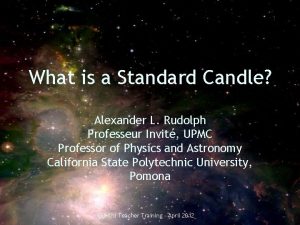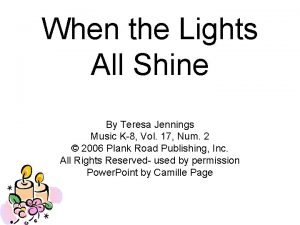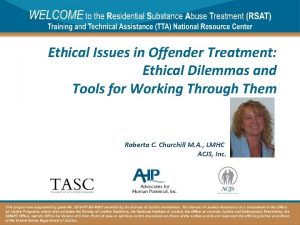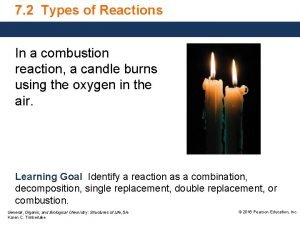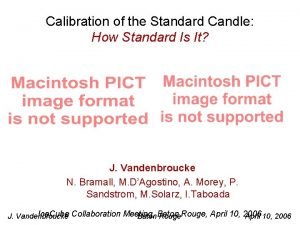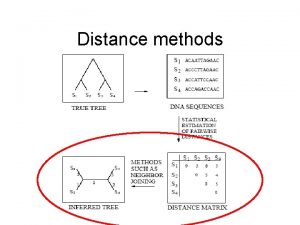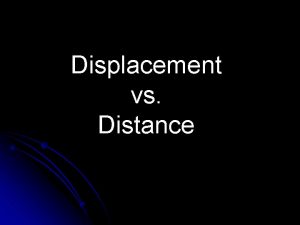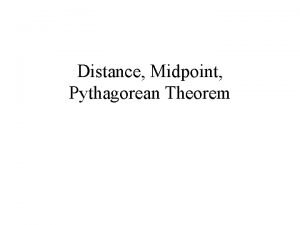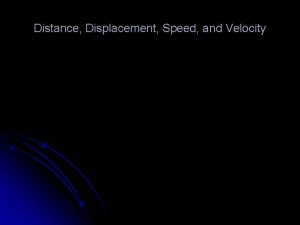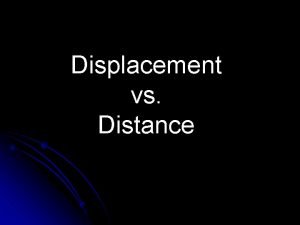Distance Methods Types of Distance Methods Standard Candle





















- Slides: 21

Distance Methods Types of Distance Methods Standard Candle Distance Methods: • Spectroscopic Parallax • Cluster Fitting • Tip of the Red Giant Branch (TRGB) • Planetary Nebula Luminosity Function • Cepheid Variable Stars • Hubble’s Law • Type Ia Supernovas • Geometric distance methods rely on fundamental relationships between sizes, angles, etc. • Standard Candle distance methods rely on objects that are believed to be consistently the same luminosity • The methods are sometimes described as a ladder • You have to use the low rungs to get the higher rungs • Some rungs are sturdier than others Geometric Distance Methods: • Radar Distancing • Parallax • Moving Cluster Method • Light Echo Method

Geometric Methods Radar Distancing • Radio waves move at the speed of light c • Bounce radio waves off a target and measure time to get an echo back • If separation of two planets is d, then the time to see the signal is: • Can only be used within the solar system • Reliability limited only by the accuracy with which we measure time • Essentially no error • This allows us to know the AU with high precision: d

Parallax (1) • We use our two eyes to judge distances using a technique called parallax p 1 p 2 • The difference between the angle seen by each of the eyes is called the parallax • It is limited by baseline, how far apart the two points you measure from are • You can use the orbit of the Earth as a baseline p p

Parallax (2) To understand what you will see, easiest to think of system as if Earth is still and star is moving in a circle: • If you view it from the edge, it looks like a straight line • If you view it from the bottom or top, it looks like a circle • If you view it from an angle, it looks like an ellipse. • The angular semi-major axis of this ellipse is the parallax • The other size depends on its ecliptic latitude • The actual size of the ellipse is 1 AU • It’s really the Earth’s orbit • We can determine distance: p sin p • This combination is called a parallax-second or parsec

Proper Motion Why it’s not that simple: • Actual paths of stars are more complicated • Because the stars are also actually moving (relative to us)! • The average motion over many years is causing the apparent position of the star to change • If we know the distance, we can measure the tangential velocity

Sample Problem At right is plotted a star’s variation in position in the sky in x (red) and y (green) over a three year period in milliarcseconds. The red curve corresponds to the major axis of parallax. What is the: (a) Angular velocity of proper motion, x and y (b) Angular speed of proper motion (c) Parallax in mas and distance in pc (d) Transverse speed vt

Gaia Spacecraft • European Spacecraft • Launched in 2013 • Measures parallax of stars m = 3 to m = 15 with an error of 0. 02 mas • Measures parallax of stars down to m = 20 with an error of 0. 2 mas • Can measure distances to center of galaxy with better than 10% accuracy • • Second data release in April 2018 Parallax and proper motion of 1. 3 billion stars Third data release in December 2020 brings total to 1. 46 billion stars More data expected next year

The Moving Cluster Method • A cluster of stars is a group of stars born from a single cloud of gas • It appears as a group of closely spaced stars • In general, they will all be born with approximately the same velocity • They are all moving together • If the cluster is moving away from you, there will be a vanishing point where they appear to be converging to a vanishing point • The vanishing point is where they end up at t = • It is the actual direction they are moving • We don’t have to wait this long to see where they are going • It’s where the projected paths intersect • Now, for any given star, measure vr, , and To vanishing point vt = vsin v vr = vcos Vanishing point

The Light Echo Method (1) • Consider a very bright source of light that turns on suddenly • Like a supernova SN 1987 a • The bright ring is probably a circle centered on the supernova • It looks like an oval because it is probably tilted compared to our point of view • We can determine angle of tilt from the shape 2 R cos Other gas rings? 2 R d • The light from the supernova comes straight to us at the speed of light • From the ring, it takes longer: • First it must go to the leading edge of the ring • Then it must come from the leading edge to our eyes • We can measure the difference in time Centered ring of gas

The Light Echo Method (2) • We can now find the actual size of the object SN 1987 a • We can also measure the angular size of the object • Note many methods give distances only to very specific objects • But many objects clearly are together • Probably at comparable distances • Measuring distance to one object gives you all such distances • SN 1987 a was in the Larger Magellenic Cloud Other gas rings? Centered ring of gas

Standard Candles A Standard Candle is any object that is consistently the same luminosity • The luminosity is normally converted to an absolute magnitude M • We can generally measure the apparent magnitude m • We can then determine the distance d: To use standard candles, we must: • Establish that they are standard candles, i. e. , show that they have consistently the same luminosity • Calibrate the luminosity of one or a few representative members • Determine its distance d by some other method • Measure the brightness / apparent magnitude m • Find M from our distance formulas Complications: • There is often some spread in M: • Either introduces error or must be compensated for • Any dust between us and a source will change m • Can be indirectly measured by comparing different filters

Spectroscopic Parallax • Uses main sequence stars • These are 90% of all stars, so not a restriction • Has nothing to do with parallax • Study many nearby main sequence stars • Get their distances by parallax • Measure their apparent magnitudes m • Deduce their absolute magnitudes M • Make a Hertzsprung Russell Diagram Now, to measure the distance to any M. S. star: • Measure the apparent magnitude m • Measure the spectral class (color) • Use H-R diagram to deduce the absolute magnitude M • Find the distance using

Sample Problem An F 5 main sequence star has an apparent magnitude of m = 14. 6. What is its distance?

Problems with Spectroscopic Parllax • Main sequence stars are not exceptionally bright • You can’t see them at vast distances • Must use other methods • The main sequence is a band, not a line • Metallicity varies significantly • Can be measured in the spectrum and compensated for • Age varies significantly • Difficult to compensate for with a single star • Use clusters!

Cluster Fitting (1) • Spectroscopic parallax on steroids • Applies to clusters of stars • Many stars with similar composition and magnitude • Plot the apparent magnitude vs. spectral type • Measure composition – metallicity • Build a computer model predicting what a set of stars would look like with this composition • Plot the absolute magnitude vs. spectral type • Age the computer generated stars until the graph has the same shape • Turn off point tells you when to stop • Compare the absolute magnitude of the result with the apparent magnitude of the actual cluster • Find the distance from M m-M m O 5 B 5 A 5 F 5 G 5 K 5 M 5

Cluster Fitting (2) Advantages • More accurate than spectroscopic parallax • Statistics of many stars helps eliminate errors Disadvantages • Relies heavily on main sequence stars • These stars are relatively dim • Cannot be used beyond our galaxy

Tip of the Red Giant Branch (TRGB) • Look at the brightest stars in the red giant branch • They will have a range of luminosities • But there is a cutoff or highest luminosity (most negative absolute magnitude) • If you look in the infrared, it seems to be almost independent of metallicity • Make a HR diagram for a collection you want to know distance to • Determine brightness at the tip mt • Find the distance Advantages • Apparently it is insensitive (in the infrared) to age and metallicity Disadvantages • They still aren’t that bright

Planetary Nebula Luminosity Function • Planetary nebulas come in a variety of luminosities • But the distribution seems to be almost independent of where they come 80 from 70 • Very little dependence on the metallicity 60 • The maximum luminosity can be determined from 50 40 nearby planetary nebulae: 30 • Find an object with several (many? ) planetary nebulas 20 • Make a histogram of number vs. apparent magnitude 10 0 • Fit to curve – determine maximum brightness m* -1 -2 -3 • Find the distance Advantages • Can see these brighter objects at larger distances Disadvantages • They aren’t that bright • You can only get distance to large objects – like galaxies -4 -5

Cepheid Variable Stars • In their giant stages, certain stars begin to pulsate • Known as Cepheid Variable Stars • The bigger the star is, the slower its pulsation • The bigger the star is, the more luminous it is • There is a relationship between the period and the luminosity/absolute magnitude P is period in days • • Measure the period of a pulsating Cepheid variable star Use this formula to determine the average visible absolute magnitude MV Measure its average apparent magnitude m. V Determine the distance from

Cepheid Variable Stars (2) Advantages • Quite accurate method • Bright, comparable to planetary nebulas • You only need one Disadvantages • Still somewhat rare stars – clusters or bigger only • Metallicity changes the relationship • Most stars near us (type I) have high metallicity • Some stars have much lower metallicity • Must be compensated for

Type Ia Supernovae • All type Ia supernovae are approximately 1. 4 MSun white dwarfs that blow up the same way. • They should all have the same maximum luminosity • Find a type Ia supernovae where you want it • Measure its maximum apparent brightness m • Find the distance using: Disadvantages • They aren’t really standard candles: • There is a spread in the maximum magnitude • There is an experimental correlation between how fast they fade and their maximum magnitude • Can be used to compensate for this problem • They are very rare – difficult to calibrate Advantages • Quite accurate method • Spectacularly bright Mixed: • So far away, other effects become important • Relativistic speeds, curvature of universe
 Standard candle
Standard candle Cepheid variable stars
Cepheid variable stars When the lights shine
When the lights shine Pope francis quotes on mission
Pope francis quotes on mission Summer poems with figurative language
Summer poems with figurative language One little candle poem
One little candle poem The bell the book and the candle ethics
The bell the book and the candle ethics Osmosis experiment using pawpaw
Osmosis experiment using pawpaw Who did elton john wrote candle in the wind for
Who did elton john wrote candle in the wind for Candle reaction
Candle reaction Yankee candle manufacturing plant
Yankee candle manufacturing plant Is a candle living or nonliving
Is a candle living or nonliving Koch and arnold steam sterilizer
Koch and arnold steam sterilizer 3 chemical properties
3 chemical properties Four candles peace faith love hope
Four candles peace faith love hope Light the advent candle one now the waiting has begun
Light the advent candle one now the waiting has begun Is a candle living or nonliving
Is a candle living or nonliving Take your candle and light the world
Take your candle and light the world Praying candle malaysia
Praying candle malaysia Lilin 4
Lilin 4 Chemical properties of a candle
Chemical properties of a candle Hathlaf
Hathlaf
